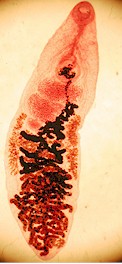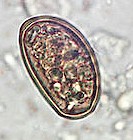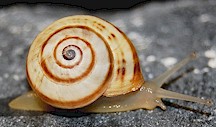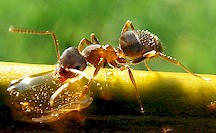Dicrocoelium is a genus of flukes with cattle, sheep, goats, pigs, and other wild animals as major final hosts.
It occasionally infests horses, dogs, cats, and also humans.
They are also called lancet flukes or small liver flukes.

There are two major species:
- Dicrocoelium dendriticum, (= Dicrocoelium lanceolatum) has a worldwide distribution but prevalence varies strongly depending on the regions.
- Dicrocoelium hospes, found in Africa.
The disease caused by Dicrocoelium is called dicrocoeliosis.
Are animals infected with Dicrocoelium contagious for humans?
Usually NOT. If livestock is infected with lancet flukes, its is not directly contagious for humans, neither through contact, nor when consuming meat, milk or blood of contaminated animals, nor through the feces. BUT it cannot be excluded that humans become infected when consuming raw livers contaminated with juvenile lancet flukes. The same applies to pets infected with lancet flukes. Normally humans become infected with lancet flukes through accidental ingestion of contaminated ants (see below under life cycle), not by ingesting adult flukes or their eggs.
You can find additional information in this site on the general biology of parasitic worms and/or flukes.
Final location of Dicrocoelium spp
Predilection sites of Dicrocoelium flukes are the bile ducts and the gall bladder.
Anatomy of Dicrocoelium spp
Adult Dicrocoelium have the flat body and the oval shape typical for most flukes. They are smaller than liver fluke, ~10 mm long and ~2 mm wide. Their body is translucent. They have 2 prominent suckers, the oral sucker and the ventral sucker, both on the anterior part. They don't have cuticular spines.
As other flukes they have no external signs of segmentation. The mouth ends in the pharynx, a muscular tube that allows sucking. The digestive system is blind (i.e. without exit: the only opening is the mouth) and not linear, as in most animals, but branched, ending in several blind ducts (called coeca).
As most flukes, lancet flukes are simultaneous hermaphrodites, i.e. they have both male and female reproductive organs.
The eggs have an oval shape and are quite small (~25x40 micrometers), have a brownish color and contain a miracidium larva.
Life cycle and biology of Dicrocoelium spp

Lancet flukes have an indirect life cycle with two intermediate hosts, a snail and an ant. It is one of the most conspicuous life cycles among the parasitic helminths.
The eggs shed by adult flukes reach the host's gut with the bile and are expelled with the feces. Once outside the host terrestrial snails ingest the eggs. Several species can act as intermediate hosts, depending on the regions and the environment, e.g. Theba spp, Zebrina spp, or Cionella spp for Dicrocoelium dendriticum; Limicolaria spp or Achatina spp for Dicrocoelium hospes.
Inside the snails young miracidia hatch out of the eggs, penetrate the intestinal wall and develop to sporocysts, which on their turn multiply asexually, each one producing up to 100 daughter sporocysts. Each daughter sporocyst can produce up to 60 cercariae in the 3-4 months that it remains inside the snail. The snail encysts these cercariae and expels them in the form of sticky slime balls that adhere to the vegetation. Each slime ball can contain up to 100 cercariae.
Several ant species can act as the second intermediate host, e.g. Formica spp or Lasius spp for Dicrocoelium dendriticum; Dorylus spp or Cematogaster spp for Dicrocoelium hospes. These ants eat the slime balls. Inside the ants, most cercariae continue their development to metacercariae that are infective for the final host (cattle, sheep, goats, humans, etc.). These cercariae remain in the hemocoele of the ant.
But one cercaria migrates to the sub-esophageal ganglion (a kind of brain) of the ant and manipulates its behavior by acting on the nerve cells. Towards the evening, instead of following the rest of the ant colony, the manipulated ant climbs on top of a blade of grass and remains there the whole night through until dawn. This increases the chance that a final host swallows it during early morning grazing.
If a final host does not ingest the infected ant, it climbs down the blade of grass, joins the other ants and behaves normally until the next evening, when the process starts again. Otherwise, if it would remain the whole day on top of the blade of grass it would dry out and die exposed to excessive sun irradiation.
Once a final host ingests the infected ant while grazing, the metacercariae are released in the gut of the host and migrate to the liver through the common bile duct (ductus choledocus), i.e. they do not migrate through the liver tissues as Fasciola flukes do. Metacercariae complete the development to adults and start producing eggs in 8 to 12 weeks (= prepatent period) after being ingested. The adult flukes feed on bile and not on liver tissues.
Harm caused by Dicrocoelium , symptoms and diagnosis

Most infections with Dicrocoelium cause no symptoms or only slight ones. However, in case of heavy infestations (up to 50,000 flukes in one animal) the bile ducts can be irritated and become distended. Chronic infestations can turn into cirrhosis. Edema and blood loss (anemia) can also develop.
Nevertheless, infections with Dicrocoelium no are not as harmful as those with Fasciola hepatica or Fasciola gigantica and fatalities are rare. Economic damage is mostly due to condemnation of the livers at slaughter and to reduced productivity of affected livestock.
Diagnosis is done by egg detection in the feces or by identification of the flukes after necropsy. However, since the eggs are passed to the intestine only when the gall bladder is emptied, a negative fecal egg count is not conclusive, i.e. there can be false negatives.
Prevention and control of Dicrocoelium spp

The most important preventative measure is to keep the snail population as low as possible. The snails that act as intermediate hosts are terrestrial, but need humidity for development and survival. Effective drainage or anything else that keeps the pastures dry will reduce the snail population.
A few anthelmintics may have a label claim against Dicrocoelium spp on livestock. There are reports on effective control with albendazole (1x15 mg/kg or 2x7.5 mg/kg for on consecutive days for sheep and cattle, 10 mg/kg for cattle), triclabendazole, netobimin (20 mg/kg) and praziquantel (20 mg/kg 2 days).
Neither macrocyclic lactones (e.g. ivermectin) nor levamisole are effective against lancet flukes.
There are very few commercial flukicides approved for use on pig, horses, dogs and cats, simply because flukes are seldom a problem for them.
Chemical control of the snails with molluscicides (i.e. snail killers) such as copper sulphate, sodium pentachlorophenate, niclosamide, etc. can make sense for very specific purposes, e.g. for treating places where livestock congregates (water holes, feeding areas, salt licks, shade trees, etc) to keep them free of snails. However, trying to eradicate snails from a property is hopeless and useless. It is virtually impossible to treat every place where they can survive and they reproduce extremely quickly. Cleaned pastures would become re-infested very fast. In addition it would be also very harmful for the environment. In fact, such molluscicides (mainly niclosamide) are approved only in a few countries as an aid in the prevention of human schistosomiasis (also called bilharziosis or snail fever).
For similar reasons, trying to eliminate the ants that act as intermediate hosts of Dicrocoelium is not advisable either. Using insecticides for this purpose is not indicated, both for economic and ecologic reasons. Whatever insecticide spread on the pastures would kill numerous beneficial arthropods as well.
There are so far no vaccines against lancet flukes. To learn more about vaccines against parasites of livestock and pets click here.
Biological control of lancet flukes (i.e. using their natural enemies) is so far not feasible.
You may be interested in an article in this site on medicinal plants against external and internal parasites.
|
Ask your veterinary doctor! If available, follow more specific national or regional recommendations or regulations for lancet fluke control. |
Resistance of Dicrocoelium spp to flukicides
So far there are no reports on resistance of lancet flukes to flukicides.
This means that if a flukicide fails to achieve the expected efficacy, chance is very high that either the product was unsuited for the control of Dicrocoelium flukes or it was used incorrectly.